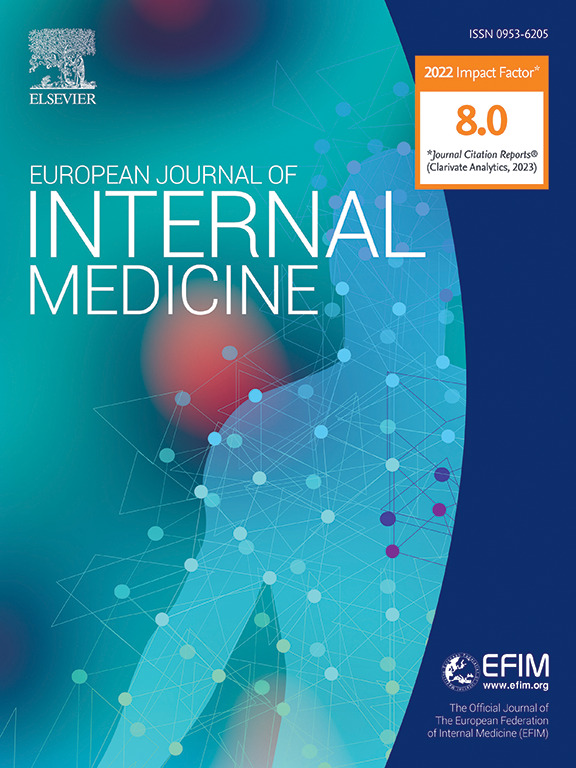巨细胞动脉炎患者永久性视力丧失的危险因素鉴定。
IF 6.1
2区 医学
Q1 MEDICINE, GENERAL & INTERNAL
引用次数: 0
摘要
目的:永久性视力丧失(PVL)是GCA最常见的缺血性并发症。我们的目的是评估临床体征、症状和GCA诊断时的血液检查异常是否可以预测PVL。患者和方法:对活检证实的GCA患者进行回顾性、多中心研究。整个队列随机分为派生和验证数据集。采用多变量逻辑回归(MVLR)建立预测模型和预测评分。通过曲线下面积(AUC)来确定模型的性能。结果:纳入620例患者,其中衍生队列397例。PVL发生率为20.3%。MVLR显示富黑朦(OR 5.86, 95%CI 3.41-10.07)。结论:GCA诊断时发生PVL的风险可通过详细的患者评估来评估,包括颞动脉。黑朦、下颌跛行和年龄较大可预测PVL。发烧是一种保护因素。炎症标志物不能区分患PVL风险的患者。本文章由计算机程序翻译,如有差异,请以英文原文为准。
Identification of risk factors for permanent visual loss in patients with giant cell arteritis
Objectives
permanent visual loss (PVL) is the most frequent ischemic complication of GCA. We aimed to evaluate whether clinical signs, symptoms, and blood test abnormalities at GCA diagnosis can predict PVL.
Patients and methods
retrospective, multicenter study of patients with biopsy-proven GCA. The whole cohort was randomly split into a derivation and a validation dataset. Multivariable logistic regression (MVLR) was used to develop a prediction model and a predictive score. The model's performance was determined through the area under the curve (AUC).
Results
620 patients were included, 397 in the derivation cohort. PVL occurred in 20.3%. MVLR showed that amaurosis fugax (OR 5.86, 95%CI 3.41-10.07, p<0.001), jaw claudication (OR 2.48, 95%CI 1.51-4.07, p<0.001), and increasing age (OR 1.09, 95%CI 1.05-1.14, p<0.001) were independently associated to PVL. Fever was the only independent protective factor (OR 0.45, 95%CI 0.25-0.84, p=0.01). The optimum cut-off for age as a PVL predictor was 78 years (OR 2.4, 95%CI 1.62-3.59, p<0.001). No laboratory variables were independently associated with PVL. Our model showed an AUC 0.80 (95%CI 0.76-0.85) and good internal validity (AUC 0.82, 95%CI 0.76-0.87). A predictive risk score with a sensitivity of 64.9%, a specificity of 82.0%, and positive and negative predictive values of 46.4% and 90.01% is proposed.
Conclusions
The risk of developing PVL at GCA diagnosis may be estimated upon a detailed patient evaluation, including temporal arteries. Amaurosis fugax, jaw claudication, and older age can predict PVL. Fever is a protective factor. Inflammatory markers do not differentiate patients at risk of developing PVL.
求助全文
通过发布文献求助,成功后即可免费获取论文全文。
去求助
来源期刊
CiteScore
9.60
自引率
6.20%
发文量
364
审稿时长
20 days
期刊介绍:
The European Journal of Internal Medicine serves as the official journal of the European Federation of Internal Medicine and is the primary scientific reference for European academic and non-academic internists. It is dedicated to advancing science and practice in internal medicine across Europe. The journal publishes original articles, editorials, reviews, internal medicine flashcards, and other relevant information in the field. Both translational medicine and clinical studies are emphasized. EJIM aspires to be a leading platform for excellent clinical studies, with a focus on enhancing the quality of healthcare in European hospitals.

 求助内容:
求助内容: 应助结果提醒方式:
应助结果提醒方式:


